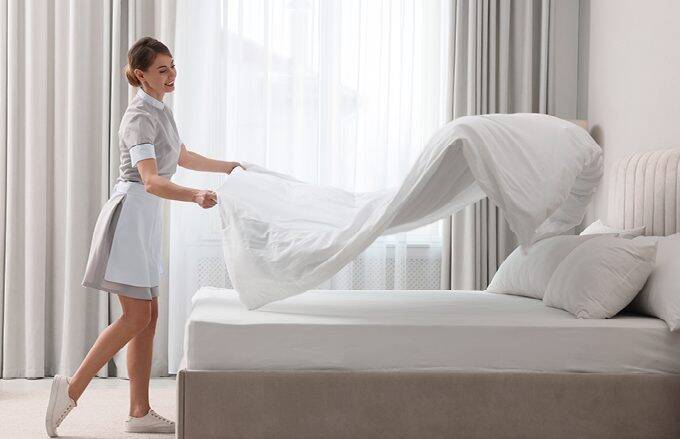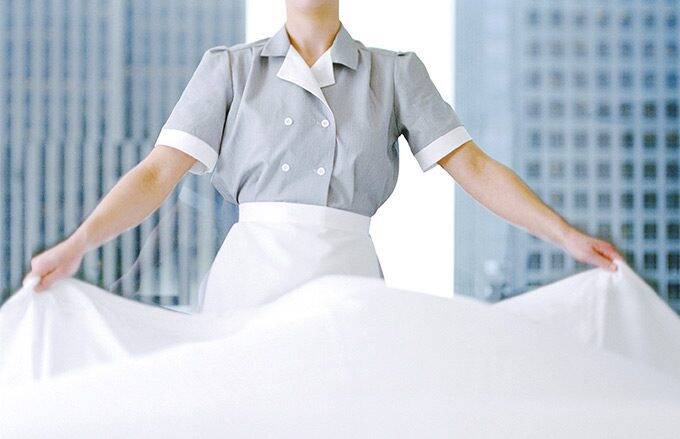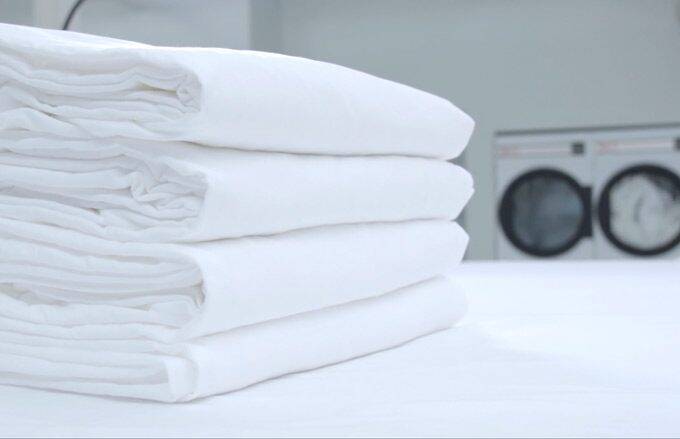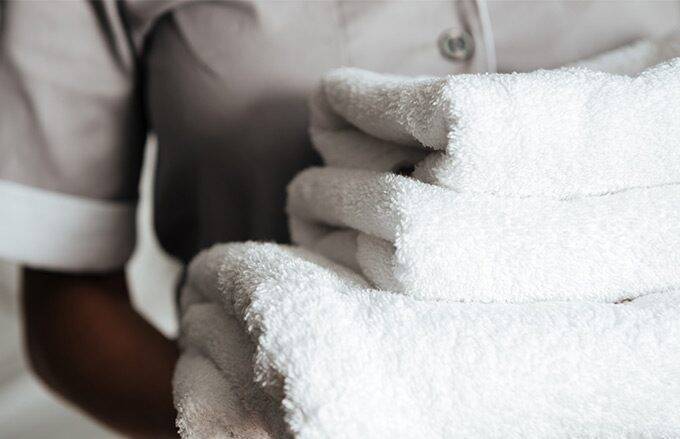April 17, 2023
Time and Motion Study | How to Help Hotel Housekeeping Improve Efficiency

Looking for our time study observation sheet? Download here
Reducing the time a task takes to complete, even by a small amount, can have a major impact on overall productivity. For example, if a housekeeper was able to reduce the time it took to clean a room by just 1 minute, over the course of a year that housekeeper would save 3,900 minutes or 65 hours (assuming 5 days per week, cleaning 15 rooms per day). That is more than 8 full working days saved just by reducing one housekeeper’s room clean time by 60 seconds!
Hospitality professionals should be constantly seeking new ways to improve their housekeeping efficiency, especially given the continued staffing shortages faced by properties of all sizes.
For many properties, a housekeeping time and motion study can be a useful tool to help evaluate the housekeeping process and potentially improve efficiency.
What is a Housekeeping Time and Motion Study?
Time studies involve observing a repetitive task or activity and recording detailed data about how the task was performed and how long the task took to complete. Studies observe a variety of workers completing the same set of tasks, allowing for the calculation of an average time to completion. To take the study even further, you can also record the body movements and distance a worker traveled during each step of the task. This is what’s known as a time & motion study, and it allows for a greater opportunity to identify inefficiencies, since it helps tell the story behind the time stamps.
These types of studies are very common in industrial manufacturing, where work is predictable and repetitive. Time and motion studies are often difficult to perform in the service industry due to the varied nature of the work. However, housekeeping is an ideal candidate for a time and motion study since housekeepers perform the same tasks each day and have a predictable pattern.
Why Are Housekeeping Time and Motion Studies Helpful?
The data gathered from a time and motion study can bring a wealth of benefits to a property:
- Identify Training Opportunities: Time studies can spotlight inconsistencies in how tasks are performed from worker to worker. This can lead to opportunities for further training and development.
- Reduce Injuries: Time and motion studies can identify which activities or behaviors are most likely to contribute to common housekeeping injuries, such as back and wrist. This will allow you to reexamine your procedures and implement safer alternatives.
- Enhance Guest Experience: Streamlining and standardizing room cleaning procedures is sure to have a positive impact on guest experience. Not only can studies create consistent cleanliness, but they also help ensure rooms are cleaned on time, reducing unhappiness associated with waiting for a clean room.
- Improve Staff Morale: This benefit is often not expected, however, by working collaboratively with housekeeping staff that can often feel isolated and forgotten, you can improve morale by allowing the team to have a say in processes and showing that you care about making their daily work simpler and faster.
- Identify bottlenecks: Time studies allow you to identify the most time-consuming aspects of your housekeepers’ day. This can lead to opportunities for reducing the time required for these tasks. For example, a recently published study found that making the bed took nearly 23% of housekeepers’ time, twice as much as the next most time-consuming task. Given these results, focusing on how to make hotel beds faster should be a top priority.
How to Perform a Time and Motion Study
Now that you understand the benefits of a housekeeping time and motion study, how do you go about performing one? We’ll break the process down into a series of simple steps:
- Identify your Goal: Defining the goal of the study is crucial. Do you simply want to understand how long each individual task takes to complete? Perhaps you’re trying to determine if staffing levels are adequate, or if further training may be necessary? Regardless, having a clear goal will help guide the study and ensure that the data collected is relevant.
- Determine the Scope: When scoping a time study, ask yourself: How many rooms will we observe? Will we look at one single room type or multiple types? Should we observe one floor or multiple floors? Do we simply want to record the time each task takes or would gathering more detailed notes/observations be beneficial? By asking these scoping questions, you’ll gain a better understanding of the resources needed to complete the study.
- Create your Observation Form: Now that you have scoped the study, you’ll need a standardized way to collect data. This is especially important when you have multiple observers to ensure consistency.
**Get started with our free time study observation sheet and customize to suit your property’s needs**
- Select Participants: Choose a group of housekeeping staff that is representative of your regular team. They should be trained, competent, and familiar with cleaning procedures. Choose a time that is representative of a standard day.
- Avoid the Hawthorne Effect: The Hawthorne Effect is when subjects alter their behavior because they know they are being studied. For example, a housekeeper may take longer on a task than usual when being observed, for fear of not cleaning thoroughly enough. To avoid this effect, it is important to communicate in advance with staff about the time study and its purpose. This conversation goes great over lunch or afternoon coffee. Explain to housekeepers what metrics are being gathered, why it’s important, and how it will benefit everyone. To the extent possible, you want your staff to feel comfortable enough to work the same way during the time study as they would any other day of the week.
What to do After the Study?
Once the time and motion study is complete, analyze the data collected. Look for patterns or outliers and use the information to identify areas of improvement. If training is needed, create a plan to address the issues identified. And importantly, engage your staff! Ask for their opinions about the data and their ideas for how to improve and streamline their work. Use all the information gathered to help determine appropriate staffing levels, resource allocation, and cleaning schedules.
One of the most important outcomes from your first housekeeping time and motion study should be scheduling your next study! With regular observations, you can identify what changes are working and where further modifications may be needed. Making time studies a regular part of your housekeeping routine will ensure you are continuously improving and engaging your staff in discussions.
How Standard Textile Products Can Help Speed Up Housekeeping
Standard Textile’s innovative hospitality products are built to save your housekeepers time and make handling linens as effective as possible. Our OneSTEP® innovation is a perfect example. OneSTEP® stands for “One Solution to Enhance Productivity” and the products do just that. While each solution offers a unique set of benefits to hoteliers, when combined they offer housekeepers and laundry professionals tools to shorten processing and room make-up time.
OneSTEP® Housekeeping Benefits:
- EZ ID® terry color-coding system enables staff to easily identify towel weights by a distinct color bar on the sew-in label.
- EZ ID® sheeting provides color-coding of the selvage yarns running down the side of the sheet, without having to compromise the luxurious appearance.
- Center-Lock Labels identify the center of a sheet when making a bed.
- Balanced Hems allow either end of the sheet to be the top.
Other Innovations:
- Our top cover products allow for the triple sheeting technique, which is much more efficient than changing duvets
- Designer closure duvets are specially engineered to make removal and stuffing as quick and simple as possible
- AllerEase® Professional mattress encasements give superior mattress protection. Plus, the zippered top can be removed and replaced much faster than a traditional fitted mattress protector.
Need More Support?
We’re more than just a textile supplier. Our passion is saving you time and money while helping you deliver an exceptional guest experience. If you have any questions on how to optimize your housekeeping processes or how textiles can help your staff be more efficient, contact us today!
Related Content

Housekeeping Tips: How to Make Hotel Beds Faster
Any opportunity to speed up the housekeeping process and make the life of a housekeeper easier is a welcome improvement. That’s why today’s housekeeping tips center around one of the most significant tasks for housekeepers – how to make hotel beds faster.

VIDEO: 5 Tips to Help Your Hotel Laundry Reduce Wrinkles
Proper laundry procedures can help prevent wrinkles, as well as extend product life. But there are ways to minimize wrinkles with just a few simple steps.

Work Smarter, Not Harder: Housekeeping Strategies for a Changing Industry
Housekeeping staff are some of the hardest working individuals in the industry, and their service and dedication significantly impacts the quality of the guest experience. Discover how the OneSTEP® solution offers a unique set of benefits, when combined they offer housekeepers and laundry professionals tools to shorten processing and room make-up time.